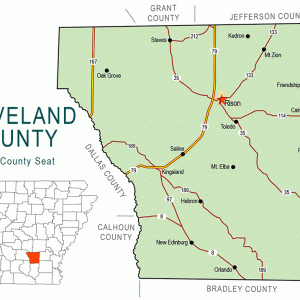calsfoundation@cals.org
Toledo (Cleveland County)
The small farming community of Toledo is located on State Highway 35, approximately three miles southeast of Rison (Cleveland County). Established in the late 1800s, it was selected as the county seat of what was then called Dorsey County and continued as the seat of government when the county’s name was changed in 1885 to Cleveland County to honor President Grover Cleveland.
With the creation of Dorsey County on April 17, 1873, a board of commissioners was appointed to select a site for the county government. They chose a site where a post office had been established in 1872, Pleasant Ridge. Shortly after the designation was made, the name was changed to Toledo, with a post office name change soon to follow.
A building located about two miles outside the town was rented from N. V. Barnett and renovated for use as a temporary county courthouse. On December 15, 1873, voters decided that a new courthouse located within the town was needed to better serve the population. Land was purchased, and a two-story frame building was constructed at a cost of $6,000. The first floor housed the county offices, with the second serving as the courtroom. A jail was built on the site about two years later.
In 1875, Professor W. A. Garner founded the Pleasant Ridge Academy. Sometime in the late 1870s or mid-1880s, the name of the respected educational institution was changed to Toledo Academy. The school was a factor in drawing settlers to the area.
In 1879, a legal plat was filed and an incorporation petition was submitted. Incorporation was granted on May 16 of that year. The town slowly began to grow and, by 1880, had a population of 143. It was soon home to several mercantile stores, three hotels, four blacksmiths, four doctors, three lawyers, four druggists, and two saloons. Many of the local men were employed at one of three area sawmills. The first newspaper, the Toledo Blade, was established in 1879, followed by the Toledo Immigrant in 1884, the Toledo Lance in 1887, and the Arkansas Siftings.
The decline of the town began with the coming of the railroad. Some sources record that the citizens of the town refused to give the railroad a right-of-way in 1882. Instead, the tracks were constructed some two miles to the north. Soon, growth began near the tracks with some of the Toledo businesses relocating there. An additional blow to the town came on March 9, 1889, when the courthouse burned; some suspected arson. The rival towns of Kingsland (Cleveland County), New Edinburg (Cleveland County), and Rison began a strong push for the removal of the county seat. Finally, after two hotly contested elections, the Arkansas Supreme Court, on April 11, 1891, designated Rison as the new county seat of government.
With the loss of its importance as a trade and governmental center, the town began a steady decline. By 1890, though the town still maintained several businesses, the population had dropped to approximately 100. By 1901, the population stood at only forty-three, with all but six citizens making their living as farmers.
As people began to move away over the years, much of the area reverted to farmland. By 2005, about all that remained of the once prosperous county seat were the Baptist church and a few residences.
For additional information:
Biographical and Historical Memoirs of Southern Arkansas. Chicago: Goodspeed Publishing Co., 1890.
Cleveland County, Arkansas: Our History and Heritage. Rison, AR: Cleveland County Historical and Genealogical Society, 2006.
Lisemby, Doris Mitchell. Taproots in Fertile Soil. Arkadelphia, AR: Autumn Years Ministries, 1993.
Mike Polston
CALS Encyclopedia of Arkansas
 Cleveland County Map
Cleveland County Map 



Comments
No comments on this entry yet.